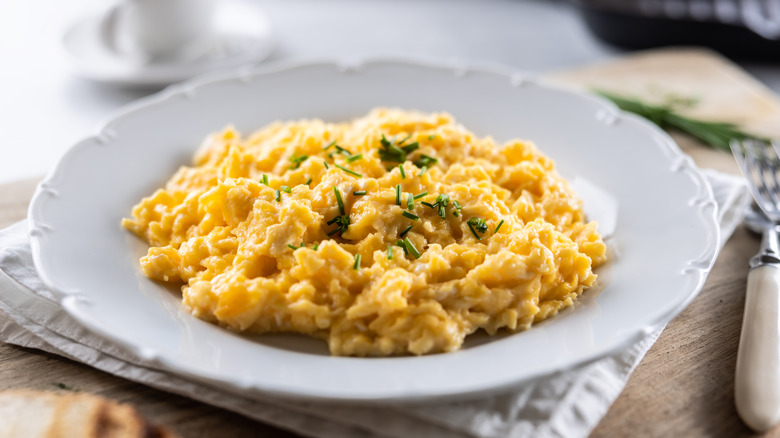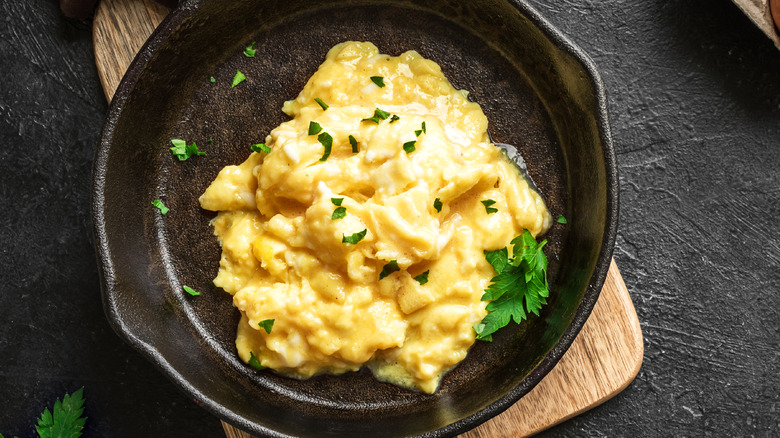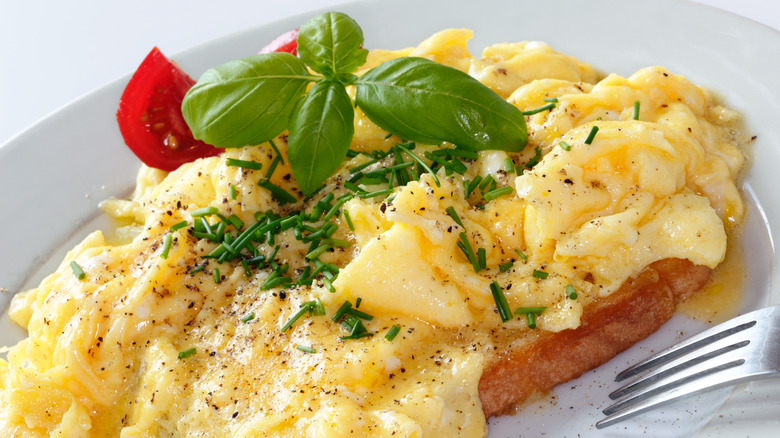The French Trick For Scrambled Eggs You Didn't Know You Needed
Many people adore scrambled eggs for breakfast because they offer a quick and effortless meal. Simply crack a few eggs, beat them until they're uniform, and then cook them in a hot pan greased with butter. A few gentle turns with a spatula, and you're good to go. This American approach to making scrambled eggs can provide a speedy breakfast, but it's also easy to get wrong, resulting in rubbery eggs that release excess water due to overheating. On the other hand, the French technique yields creamy eggs with consistent texture. The key to achieving French-style eggs is to reduce the heat and allow the eggs a bit more time to set.
The low-and-slow method of making scrambled eggs makes all the difference. It offers better control over texture, resulting in luxurious eggs rather than chunky and overcooked ones. Whether you choose to add a touch of milk, water, cream, or even mayo to scrambled eggs, as some celebrity chefs do, the French way of cooking over low heat is the superior method.
Use lower heat for the best scrambled eggs
Mastering the French approach to scrambled eggs hinges on heat management. Regardless of whether or not you incorporate a special element for added flavor, the secret, according to famed French Chef Jacques Pepin, is to prevent the eggs from overcooking. This can be achieved by using medium-low heat and continuously stirring throughout the cooking process, setting a bowl with the eggs over simmering water, or intermittently removing the pan from the heat.
All three techniques maintain control over the heat, ensuring the eggs don't overcook. The on-and-off method is slightly quicker than using low heat continuously, which can take up to 30 minutes. When the eggs are just about done, Pepin kills the heat and adds a colder element, such as a few tablespoons of reserved scrambled egg or some cream, to stop the cooking.
Essential to this method is stirring the eggs continually so that small, delicate curds form, as opposed to the larger, firmer ones found in American scrambled eggs.
Is it safe to consume French-style scrambled eggs?
As with all egg dishes, it's crucial to cook them thoroughly to avoid potential foodborne illness. Even with the French method of making scrambled eggs, which results in a loose texture, you must ensure that the eggs reach 155 degrees Fahrenheit to guarantee they are safe to eat, in line with FDA guidelines.
The texture of the eggs won't reveal the entire story, so if you have any doubts or are serving the eggs to individuals with compromised immune systems, it's advisable to use an instant-read thermometer.
Similarly, if you intend to hold the eggs for a specific period (for example, for a buffet or for serving later), they must be maintained above 135 degrees Fahrenheit. Any eggs designated for refrigeration should be cooled to 70 degrees Fahrenheit within two hours and stored at refrigerator temperature, which is 40 degrees Fahrenheit, within four hours. The eggs should also be reheated to the proper temperature before serving.


